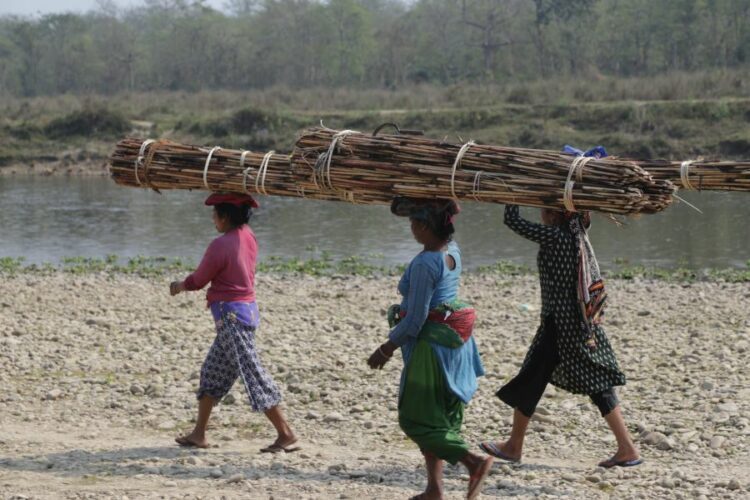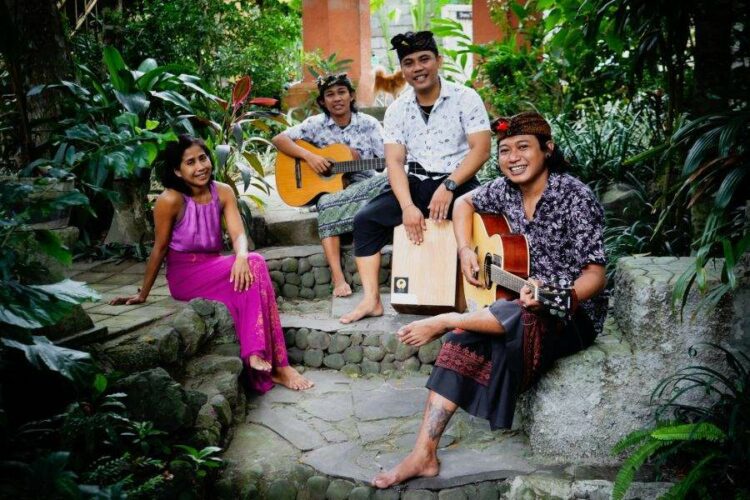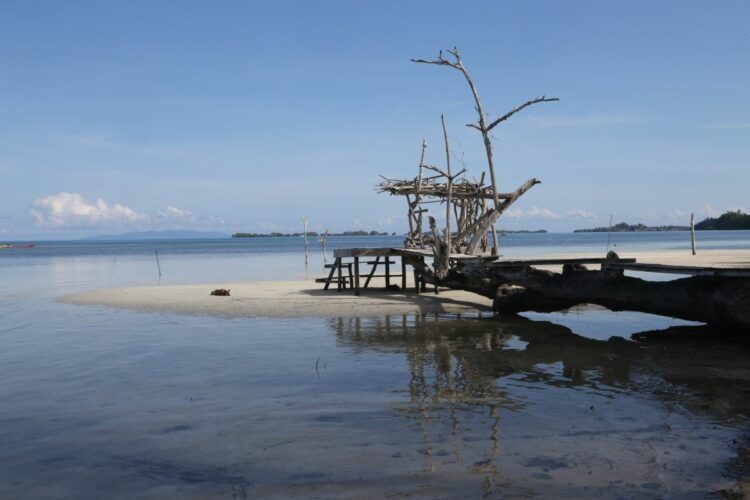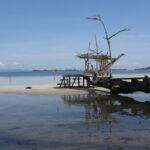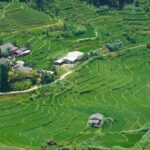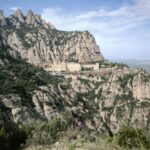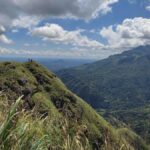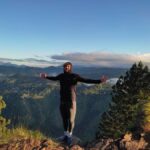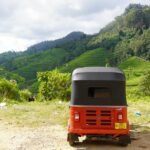Safari in Chitwan National Park
Before we went to Nepal, we honestly didn’t pay much attention to the wildlife. We were primarily interested in the country’s diverse treks and the people. When we heard that there are rhinos in Nepal and that the Chitwan National Park offers very good chances of seeing them, it was immediately clear to us that we HAD to go there. Julian in particular, as a declared wildlife lover, was immediately hooked. Besides rhinos, Nepal also has a relatively large population of Bengal tigers, sloth bears, bison, wild elephants and leopards.


General information about Chitwan National Park
Chitwan means heart of the jungle. The national park is located in the south of the country on the border with India. It is located about halfway between Kathmandu and Pokhara and is easily accessible from both cities. The national park is located in the flat Terai, the fertile lowland plain that stretches south of the Himalayas in India, Nepal and Bhutan from the Yamuna in the west to the Brahmaputra in the east. The park landscape is very diverse: from jungle and grassland to rivers and forests, it has it all.
The Tharu people
The Tharu largely inhabit the Terai of Nepal and the north of India. They describe themselves as people of the forest and are usually very familiar with it. Some of them therefore work as guides for walking safaris. They live in very original settlements, mostly in mud huts with a thatched roof, and maintain their old traditions. Many are also involved in handicrafts such as making furniture from rattan and pottery. The majority, however, live from agriculture and livestock farming.


What animals live in Chitwan National Park?
The “stars” of the national park are rhinos and the Bengal tiger, although the latter is only seen by very lucky visitors. There is also a good chance of seeing wild elephants, bison, swamp crocodiles, sloth bears, monitor lizards, Gangetic gavials, peacocks, eagles, Sambar deer, monkeys, deer and many other mammals, reptiles, birds and amphibians.


Monitor lizard 

Rhino in the undergrowth
What safari offers are there?
The bottom line is that there are 3 possible safaris that you can book. However, we strongly advise against the safari on an elephant, as they are kept in very poor conditions.
Option 1: Walking Safari (Our recommendation)
Doesn’t that sound like pure adventure? You walk through the park with 2 guides and try to spot animals. The guides are heavily armed in case of emergency – with a stick! Equipped with binoculars and enough provisions, the safari lasts a whole day, from 7:00 in the morning until late afternoon. The atmosphere is indescribable, no motors, no chatter of people, just the sound of nature. The guides are experienced trackers and can provide you with exciting information about the animals. Unfortunately we couldn’t see a tiger, although we saw the remains of its prey, its poop, scratch marks on the tree and tracks! Our highlight was the encounter with 2 rhinos that were taking a siesta about 50 m away from us.
Option 2: Jeep Safari
The classic variant is the jeep safari, which looked less attractive to us in Nepal. There were many local tourists for whom the jeep ride was more like a visit to an amusement park. However, these are just our observations, but locals confirmed similar things to us on site.
Option 3 : Elephant Safari
We strongly advise against this option after seeing how the elephants were treated. Besides the elephants for “tourism purposes”, there are also the government elephants, which in turn are used as farm animals and are well cared for. These are often used for patrolling the jungle or for salvage.


Itinerary of a Walking Safari in Chitwan National Park
First, you meet your guides at the agreed meeting point at 7:00 in the morning. A boat carved out of a wooden trunk is used to cross the river, which is also the entrance to the national park. Before the actual safari started, there was a short briefing by the guides on how to behave towards the large animals in an emergency in order to minimise the danger.
Wild elephant:
Here you should somehow try to put about 150 m between you and the elephant, as from this distance it no longer sees you as a serious threat and you have a good chance of being left alone.
Sloth Bear:
When coming into contact with the sloth bear, the aim is to stand as close to each other as possible and thus appear as big as possible. They also shout to intimidate the bear.
Rhino:
As rhinos can smell very well but see very poorly, it is best to get behind a tree or climb up on it when running away. While running away, you should throw pieces of yourself, as the smell irritates the animals and they may stop for a moment, thus buying you some time.
Tiger:
With the tiger, it only helps to pray, as it is superior to us in all respects. You can only hope that the tiger is not interested in you, as tigers are usually rather shy animals.
Afterwards, several different places in the national park are visited on foot. We walk through grasslands, thickets, jungles, along the riverbanks to various spots where we wait in the hope that the animals will show themselves. Often these spots are located on easily visible parts of the riverbank. Even if you cover a few kilometres, the safari is quite manageable for people of normal physical fitness, as there are plenty of breaks. Around 12:00 hrs there is a lunch break. The safari ends at around 4-5 p.m. and you leave the national park by boat. Fun Fact: We were given a briefing, but no mention was made of the danger of a bison. One of them almost ran us over when it felt threatened and made enormous noises.
How much does a safari in Chitwan National Park cost?
Unfortunately, I cannot give exact prices for the jeep or elephant safari. A safari on foot costs around 4,300 (NPR) per person. Of the 4,300 NPR, 2,000 NPR are for the entrance fee to the national park. So the two of us paid just under €65 for the whole day and felt that the price was relatively fair. The four-hour jeep safari in a shared jeep with up to 10 people costs about the same as the walking safari.
Should I book my safari in Chitwan National Park in advance?
Very clear answer – no! We recommend walking to the riverbank where all the guides hang out and just talking to some of them. From the riverbank, with a bit of luck, you can already see rhinos and crocodiles. The guides hang around this place and are happy to give you a taste of their expertise, so you can simply arrange a safari for the next day according to sympathy and feeling. For Naomi, for example, it was also particularly important that she felt safe in the care of the guide. Unfortunately, when you book with a travel agency, you never know who you will get. In addition, the travel agency collects a large part of the commission, although the service, at least in our opinion, is provided by the guide himself. He should be paid for this.
Overnight in Chitwan
There is no shortage of possible accommodation in the small village. We stayed at the Evergreen Eco Lodge for just under 600 NPR (~ 5 €) per night and were very enthusiastic. The individual huts were built from recycled materials such as tyres or bottles. Our accommodation was more or less a jeep. The food was highly recommended, both in terms of price and taste.
What do I need for a safari?
- sun cream
- something thin to put on for the morning
- Camera with telephoto lens if available
- Clothing without warning colours like orange, red, yellow.
- At best long trousers with detachable trouser legs
How to get to Chitwan
The journey to Chitwan National Park is by bus. There are two types of buses that take you to the town of Sauraha. The tourist bus and the local bus. As the national park is located right between the tourist centres of Kathmandu and Pokhara, the journey is very easy. You get off at “Sauraha Chok”. From there you can get to Suraha by tuk tuk or another bus. The tourist bus, however, goes directly to Sauraha. The public bus from Pokhara costs 450 NPR and the tuk tuk to Sauraha costs 150 NPR. From Kathmandu, the price should be similar.
What else can you experience in Sauraha?
Tharu villages and 20.000 Lake
The small town of Sauraha is very much geared towards tourism. Besides the safari offers, it is nice to rent a bike and cycle through the surrounding Tharu villages and make a trip to 20,000 lake. We found 20,000 lake quite nice, but would not go there again as it was very hot and a good walk with the bikes. It has to be said that the bikes look really good at first glance but are incredibly uncomfortable. My backside hurt for days afterwards.


Sunset at the park entrance
In the evening, at sunset, there is a good chance of spotting wild animals on the riverbank. Also, rhinos sometimes come to the village to get their food and then disappear again. While we were there, one came trotting calmly through the village.





